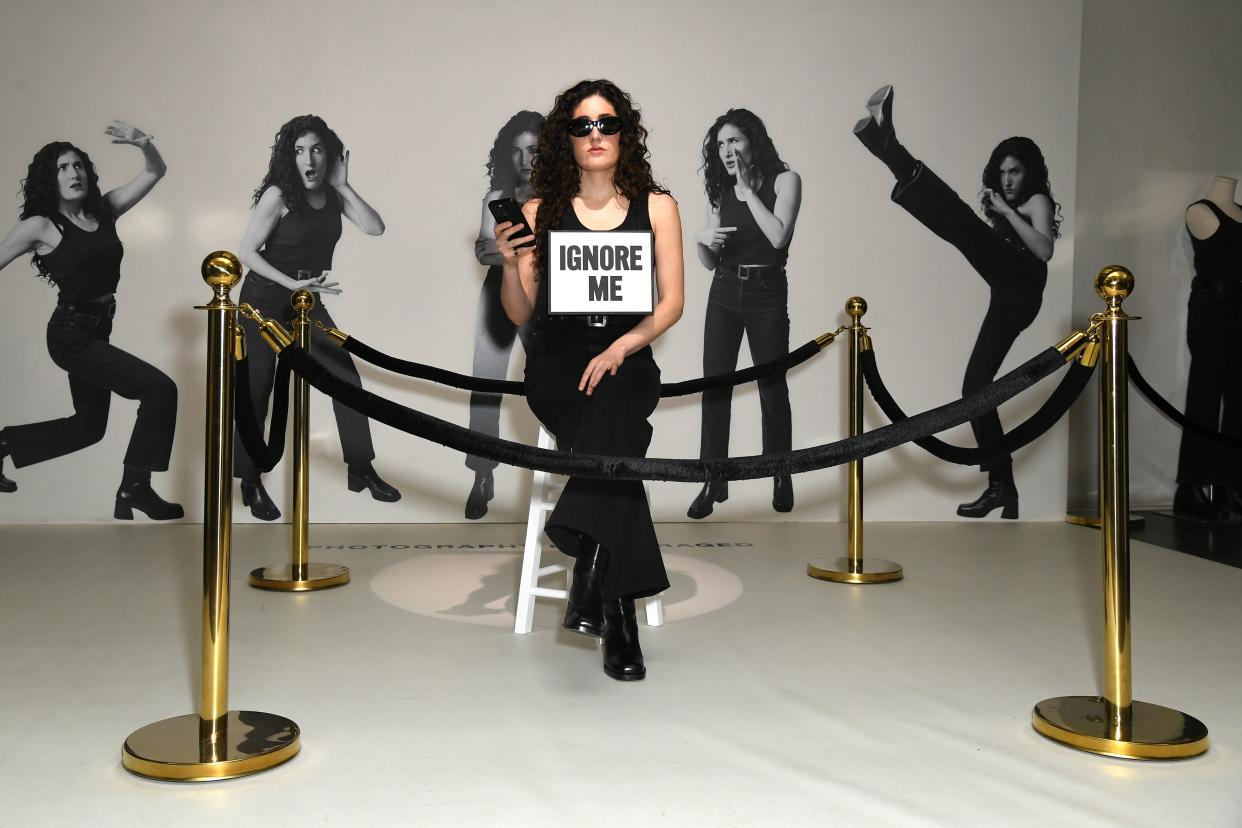Kate Berlant is Not Comfortable Until You’re Uncomfortable

JC Olivera/Getty Images
Even before Kate Berlant steps onstage, the audience at her stage show KATE has already encountered the performer throughout the theater. Her image is plastered on banners outside, her name is emblazoned in all caps on the ushers' t-shirts, and little cutouts of her are taped to the walls in the bathroom. In the lobby, Berlant herself sits on a stool behind a velvet rope with a spotlight on her, wearing sunglasses and a sign around her neck that reads: “IGNORE ME”. As people settle into their seats, a slideshow plays on stage—black and white images of Kate pacing dramatically, as if psyching herself up just beyond the scrim, along with photos of famous theater practitioners (Stanislavski, Adler, etc.) demonstrating the exaggerated seriousness with which Kate from KATE (a character who both is and is not Kate Berlant) takes herself and her career.
One of the final slides reads: “If you enjoy the show, don’t hesitate to reach out”; the following slide includes two headshots of her agent and manager with their emails and phone numbers. This becomes one of the show’s motifs — that Berlant, known for her stand-up and her collaborations with John Early, has resigned herself to doing theater in an effort to drum up more work in film and television. “That's the joke of the show,” Berlant tells me over the phone, “and that also is the reality of my life…I'm trying to actively get work.”
Berlant has a writing style, sense of humor, and look that conservative Hollywood values would deem “unconventional.” She often references her ‘expressive features,’ as if reciting a specific criticism from a casting director. The show presents her origin story — the pivotal events that led to her life as an actress, from her “rough” upbringing to a fateful encounter with a producer. Each vignette is peppered with clichés and tropes blurring the line between truth and fiction. The fourth wall is broken within the first few minutes: Kate starts off as a hokey stagehand with a broom and a newsboy cap and suspenders, who speaks to the audience, sweeping the stage and talking about “Miss Kate” as though she were a big star. The opening monologue hits all the cliches with a rhythm so familiar and so cringe that people laugh even though there are no real jokes.
The fourth wall is broken again when Berlant starts speaking to the audience as Kate to acknowledge the audience's discomfort. She drops her stagehand accent and says something along the lines of, “I’m gonna stop for a sec— you guys look freaked out.” The show is made up of these moments, in which Berlant slips in and out of the narrative, making use of the tropes of theater without being tied to them; she manages to distance herself from their saccharine qualities while also exploiting their function.
Since it's not the typical stand-up format with a joke and a punchline, there are moments when the audience has to wade through silence or seriousness. Berlant said she was nervous about this. “Certain parts of the show made me really uncomfortable,” she says, “because I could tell certain people were confused or were unsure how to react, which is what has to happen for the show to be effective at all.” But Berlant also relishes this discomfort, often anticipating the audience's reaction, allowing it to settle and swiftly moving us out of it.
“I've seen almost no theater in my life, is the truth," Berlant tells me. “People, understandably, assume or think that I have. And I think maybe the fact that I'm not in that world at all allowed me to kind of be bold—bold enough to be like, I'm going to mount a theater show.” The show has a confidence that isn’t bogged down by an outdated reverence for theater. It’s as fast and loose as Berlant’s standup, but has a kind of technical precision that employs all aspects of live performance. But there’s a kind of ambivalence toward the medium of theater at first. Further into the show Kate breaks down and begins mocking the audience, saying that the crowd is not that big, making fun of the venue’s location (in Pasadena, far from Hollywood.) By expressing her frustrations up front, she exposes herself to the audience but couches them in these clichés of a frustrated diva. But even as she does this, Berlant is using the medium to its full potential — mounting a real theater production.
Parts of KATE bring to mind the Eve character in the 1950 film All About Eve, in which a plucky understudy slowly takes over the post of Bette Davis’s diva. In an early scene, Eve, with false modesty, tells a sob story about how the theater saved her in her loneliness. She’s able to manipulate her small audience, drumming up sympathy from them—but it turns out to all be fabricated. It’s also a film about theater versus film, and seems like an obvious point of reference for the show. When I mentioned this association to Berlant, she agreed, then walked it back, admitting to me that she’d just caught herself in a lie: She had not, in fact, seen the film.
Originally Appeared on GQ


